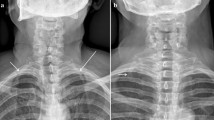Abstract
Klippel-Trenaunay and Parkes Weber (Klippel-Trenaunay-Weber) syndromes consist of vascular malformations of the capillary, venous and lymphatic systems combined with soft tissue and bone hypertrophy of the affected extremity. Klippel-Trenaunay syndrome is a pure low-flow condition, while Parkes Weber syndrome is characterized by significant arteriovenous fistulas. The distinction of both entities is relevant, since the prognosis and therapeutic strategies differ significantly. Our purpose is to demonstrate that thick-slice dynamic magnetic resonance projection angiography (MRPA) is a non-invasive tool to detect arteriovenous shunting in Parkes Weber syndrome. Four patients underwent MR imaging and MRPA. MRPA demonstrated arteriovenous shunting in three patients. Arteriovenous shunting was characterized by early appearing draining veins. The time of arrival between normal arteries and pathological veins varied between less than 0.5 and 1.0 s. Therefore, the diagnosis in these cases could be specified as Parkes Weber syndrome. In all these cases, arteriovenous shunting was confirmed by intraarterial digital subtraction angiography. One patient showed normal results in MRPA and could be diagnosed as having Klippel-Trenaunay syndrome.


Similar content being viewed by others
References
Capraro PA, Fisher J, Hammond DC, Grossman JA (2002) Klippel-Trenaunay sydrome. Plast Reconstr Surg 109:2052–2060
Cohen MM (2000) Klippel-Trenaunay syndrome. Am J Med Genet 93:171–175
Cohen MM (2002) Vasculogenesis, angiogenesis, hemangiomas, and vascular malformations. Am J Med Genet 108:265–274
Orszagh M, Schulte DM, Korinthenberg R, Schumacher M (1999) Analysis of hemodynamics by MR-Angio and embolization of Klippel-Trenaunay-Weber syndrome: 5-year follow-up. Rivista di Neuroradiologia 12 [Suppl 2]:127–131
Kanterman RY (1997) Klippel-Trenaunay and Parkes-Weber syndromes. Am J Roentgenol 169:311–312
Zoppi MA, Ibba RM, Floris M, Putzolu M, Crisponi G, Monni G (2001) Prenatal sonographic diagnosis of Klippel-Trenaunay-Weber syndrome with cardiac failure. J Clin Ultrasound 422–426
Roebuck DJ (1997) Klippel-Trenaunay and Parkes-Weber syndromes. Am J Roentgenol 169:311
Noel AA, Gloviczki P, Cherry KJ, Rooke TW, Stanson AW, Driscoll DJ (2000) Surgical treatment of venous malformations in Klippel-Trenaunay syndrome. J Vasc Surg 32:840–847
Donelly LF, Adams DM, Bisset GS (2000) Vascular malformations and hemangiomas: a practical approach in a multidisciplinary clinic. Am J Roentgenol 174:597-608
Yakes WF, Rossi P, Odink H (1996) Arteriovenous malformation management. Cardiovasc Intervent Radiol 19:65–71
Burrows PE, Mulliken JB, Fellows KE, Strand RD (1983) Childhood hemangiomas and vascular malformations: angiographic differentiation. Am J Roentgenol 141:483–488
Paltiel HJ, Burrows PE, Kozakewich HP, Zurakowski D, Mulliken JB (2000) Soft-tissue vascular anomalies: utility of US for diagnosis. Radiology 214:747–754
Fordham LA, Chung CJ, Donnelly LF (2000) Imaging of congenital vascular and lymphatic anomalies of the head and neck. Neuroimaging Clin N Am 10:117–136
Rak KM, Yakes WF, Ray R, Dreisbach JN, Parker SH, Luethke JM, Stavros AT, Slater DD, Burke BJ (1992) MR imaging of symptomatic peripheral vascular malformations. Am J Roentgenol 159:107–112
van Rijswijk CS, van der Linden E, van der Woude HJ, Bloem JL (2002) Value of dynamic contrast-enhanced MR imaging in diagnosing and classifying peripheral vascular malformations. Am J Roentgenol 178:1181–1187
Trop I, Dubois J, Guibaud L, Grignon A, Patriquin H, McCuaig C, Garel LA (1999) Soft-tissue venous malformations in pediatric and young adult patients: diagnosis with Doppler US. Radiology 212:841–845
Hennig J, Scheffler K, Laubenberger J, Strecker R (1997) Time-resolved projection angiography after bolus injection of contrast agent. Magn Reson Med 37:341–345
Sonnet S, Buitrago-Téllez CH, Scheffler K, Strecker R, Bongartz G, Bremerich J (2002) Dynamic time-resolved contrast-enhanced two-dimensional MR projection angiography of the pulmonary circulation: standard technique and clinical applications. Am J Roentgenol 179:159–165
Aoki S, Yoshikawa T, Hori M, Nanbu A, Kumagai H, Nishiyama Y, Nukui H, Araki T (2000) MR digital subtraction angiography for the assessment of cranial arteriovenous malformations and fistulas. Am J Roentgenol 175:451–453
Tsuchiya K, Katase S, Yoshino A, Hachiya J (2000) MR digital subtraction angiography of cerebral arteriovenous malformations. Am J Neuroradiol 21:707–711
Griffiths PD, Hoggard N, Warren DJ, Wilkinson ID, Anderson B, Romanowski CA (2000) Brain arteriovenous malformations: assessment with dynamic MR digital subtraction angiography. Am J Neuroradiol 21:1892–1899
Wetzel SG, Bilecen D, Lyrer P, Bongartz G, Seifritz E, Radue EW, Scheffler (2000) Cerebral dural arteriovenous fistulas: detection by dynamic MR projection angiography. Am J Roentgenol 174:1293–1295
Klisch J, Strecker R, Hennig J, Schumacher M (2000) Time-resolved projection MRA: clinical application in intracranial vascular malformations. Neuroradiology 42:104–107
Yoshikawa T, Aoki S, Hori M, Nambu A, Kumagai H, Araki T (2000) Time-resolved two-dimensional thick-slice magnetic resonance digital subtraction angiography in assessing brain tumors. Eur Radiol 10:736–744
Arnold SM, Strecker R, Scheffler K, Spreer J, Schipper J, Neumann HPH, Klisch J (2003) Dynamic contrast enhancement of paragangliomas of the head and neck: evaluation with time-resolved 2D MR projection angiography. Eur Radiol 13:1608–1611
Goldman JP, Lookstein R, Marin M (2003) Rapid functional CE-MRA in determining direction of contrast flow: initial feasibility and clinical applications. Proc Int Soc Mag Reson Med 11:323
Acknowledgements
All patients were presented and discussed at the interdisciplinary conference “Hemangiomas and Vascular Malformations” at the University Hospital Freiburg. We thank all persons who contributed to and participated in this conference.
Author information
Authors and Affiliations
Corresponding author
Rights and permissions
About this article
Cite this article
Ziyeh, S., Spreer, J., Rössler, J. et al. Parkes Weber or Klippel-Trenaunay syndrome? Non-invasive diagnosis with MR projection angiography. Eur Radiol 14, 2025–2029 (2004). https://doi.org/10.1007/s00330-004-2274-8
Received:
Revised:
Accepted:
Published:
Issue Date:
DOI: https://doi.org/10.1007/s00330-004-2274-8




